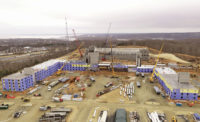Construction continues at a frenzied pace in the MidAtlantic region, thanks in part to a flurry of senior-living projects in urban areas and public work, including water supply projects and the release of delayed federal projects after Congress approved a major spending bill in March, local contractors say.
The 70 participating firms in this year’s ENR MidAtlantic Top Contractors survey posted a combined $26.1 billion in revenue in Delaware, Maryland, Pennsylvania, Virginia, West Virginia and the District of Columbia. The 67 firms that responded to last year’s survey reported $22 billion in work performed and billed.
With $2.61 billion in revenue, Clark Group unseated Whiting-Turner ($2.46 billion) as the top-ranked firm. Last year, Whiting-Turner reported $2.45 billion in revenue; Clark had $2.39 billion.
Kiewit Corp. ranked No. 3, jumping three slots in this year’s survey after posting $1.35 billion in revenue, up from $877.89 million. Kiewit reported that 42% of its work came in the power sector, 36% in the petroleum sector and 19% in transportation.
Thirty-three firms reported that the general building sector was their top category in 2017. But Michael Berardi, senior vice president at No. 29-ranked Wohlsen Construction ($254.4 million in regional revenue), says there is strength nearly across the board. “It’s been a good couple of years in terms of opportunities,” he says.
Some firms participating in this year’s survey pointed to an aging population as one reason for the growth in senior centers in densely populated cities and suburbs. Neil Stablow, Donohoe Construction Co. senior vice president, says that while low-rise, nonprofit senior living facilities traditionally have been built in the suburbs, the number of for-profit owners building midrise, luxury assisted living complexes is climbing.
“What you’re seeing now is a trend toward urban design of senior living,” says Stablow. For example, Donohoe is constructing an eight-story senior living facility in Bethesda, Md. The $27-million Brightview Bethesda project will have 113 memory care and assisted living units on a 122,225-sq-ft site. Donohoe was ranked No. 22 in the Top Contractors survey for the second-straight year, with $322.69 million in regional revenue, up from $262.67 million.
Wohlsen’s Berardi says locating senior living facilities in urban centers make it easier for relatives to visit loved ones. “People always say we should have them in some resort town,” Berardi says, “but, no, they need to be where the son or the daughter is.” Wohlsen is constructing several senior facilities, including Atria Lafayette Hill, a $30-million, 131,000-sq-ft project in Lafayette Hill, Pa., a Philadelphia suburb.
The public sector also has been a source of major regional projects. For example, this year’s firms collected nearly $7 billion in water supply work in 2017 compared with $6.1 billion in 2016.
Clark’s largest project to break ground last year was at Baltimore’s Back River wastewater treatment plant. The $430-million project is projected to alleviate more than 80% of sewage overflows in the area—a necessity highlighted by Baltimore’s wettest July in history. July’s heaviest storms resulted in 45 million gallons of sewage and stormwater overflowing into Baltimore’s waterways in just a four-day period. The project, a joint venture with No. 47-ranked Ulliman Schutte Construction LLC, will ultimately increase the facility’s influent capacity to 469 million gallons per day from 180 mgpd.
Related Link
ENR Mid-Atlantic 2018 Top Contractors
Federal Outlook
Despite the bright regional picture, Berardi says he has seen some developers and investors “tapping the brakes” on projects in the design phase because of the recent upturn in materials costs related to tariffs on steel and aluminum. That mostly has affected sectors such as senior living and office buildings. “It’s becoming increasingly problematic,” he says, “not only in terms of the final price, but if you don’t buy early the price continues to rise.”
But Berardi is optimistic that President Donald Trump and the European Union’s joint effort to eliminate tariffs and trade barriers will “minimize the ripple effect tariffs have had on all material costs.”
Some contractors in the region also worry that the federal government’s crackdown on immigration will worsen an already tight labor market. William Karbach, chairman and CEO of the Branch Group, says he would like to see more immigrants legally authorized to work under a “well-regulated” immigration policy. “Generally,” he says, “I don’t think the industry cares where [workers] come from, we just want to make sure there’s enough bodies.”
Karbach, whose firm ranks No. 25 on this year’s list, with $297.10 million in revenue, is concerned that the labor shortage will continue to cause subcontractors to default or go bankrupt. He says that could have a “snowball effect” that might even cause entire projects to fail.
While tariffs and immigration policies create uncertainty for firms, the $1.3-trillion omnibus spending package enacted in March has released federal projects that had been frozen since the Trump administration took office. Chris Brandt, Hourigan Construction executive vice president, welcomes the work. He says his firm’s federal portfolio decreased from approximately 20% to between 5% and 10% in the last four years, and could take another three or four years to rebound to the 20% mark.
Hourigan, ranked No. 35 with $199.75 million in revenue, at press time was bidding for several federal projects, including a $30-million Navy SEAL training center in Virginia Beach that includes multiple tactical training buildings on a 15-acre site. Hourigan is also constructing a $40-million Explosive Ordinance Demolition Operations and Logistics Facility for the Naval Facilities Engineering Command in Virginia Beach that will be completed by the end of the year. The project includes three buildings, the largest of which is 125,000 sq ft.
Brandt says federal work helped his firm maintain profitability during the last recession and “will certainly fill a portion of a hole if something happens with other markets moving forward.”







Post a comment to this article
Report Abusive Comment